Albert Barber, Hugh Sheppard, Bill Jenkin
We were: Hugh was standing in Whitehall. Bill had joined the Beeb just 10 days before this, and went to the lying-in-state but not to see the funeral cortege.
(Click on the picture below to see a larger or clearer version of this picture:
Click the “X” button (top right) to close the newly opened picture.)
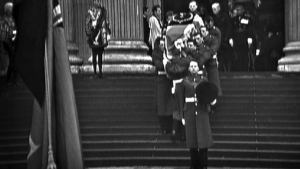
Peter Neill
I was working in the VT library under Helios. I have three memories.
Bearing in mind the fact that Winston Churchill was at death’s door for several days, Pres published a detailed schedule of options for when he finally went. I kept a copy of this for many years.
Secondly, on the day after the funeral we were inundated with “retention slips” preventing any tape being wiped for five years. This was unheard of—the norm was six months.
And the different approaches by the American networks were interesting. One had an edit suite at TC and DRd the edited tape to Heathrow. Another had a mobile edit at LHR with a plane waiting to take off. The third had an edit machine on a plane so they were able to edit on the way home!
Jim Kinally
l was in Pres. and we were rehearsing the obituary for Winston Churchill, a few days before he died, and all I had was a close up of the caption which was black on white. We finished and turned round, about 15 minutes before starting our evening session, I pointed at the set and checked the viewfinder and, you’ve guessed it, there on the screen was a nice black image saying “DEATH OF SIR WINSTON CHURCHILL”. Who forgot to switch on the ‘Orbit’? I spent a frantic 10 minutes waving the camera at a soft light, and finally cleared it with a few minutes to spare – a lesson learned the hard way, must have shortened the life of the tube a bit!
Jeff Baker
Some of you may remember the old Radio OB gear, comprising the OBA8, the TV25 (trap valve amplifier) and various other items that we in Tel OBs used in those days when we had to ‘de-rig’ a control or mixing position without a vehicle. I had recently been on TO 18 and had been sent to join tel OBs at Wembley. I claim no credit for the following, but it does illustrate how effective BBC training was at the time.
I was detailed to take care of the commentary position in the Triforium at the rear of the Cathedral. On the day, Richard Dimbleby, myself, and a Stage Manager shared the amazing view down to the Altar and all was well as we went on the air. Within a short time, the talkback feed from the TV scanner failed and Richard was ‘flying blind’ and looking to me for a solution. Fortunately, my headphones were plugged into the input listen jack and I still had talkback, so I solved the immediate problem and substituted Richard’s headphones for mine. Removing the front panel revealed that the valve had come out of its socket, so was easily and quickly replaced. This restored the main output of the amplifier and gave Richard a volume control again. I wonder if I would have dived in so quickly if today’s Health and Safety culture had been in place.
Peter Cook
During rehearsals it seems that Anthony Craxton showed Richard Dimbleby a panoramic pan from a camera high up, probably on St Paul’s. “If we have to fill, Richard, how long do you think you could talk over that shot for?” Crackers asked. The reply? ” Oh about 4 hours”. Richard was well known for his research which he kept on cards. This resulted in him never being stuck for something RELEVANT to say, a habit that may not have been passed down the family.
Peter Coombes
Richard Dimbleby’s preparation was famously put to the test on the occasion of Princess Margaret’s wedding in 1960. By the time the couple arrived at Westminster pier, fifty minutes late, RD had “… exhausted every last comma of his associative material…”. Perhaps he had more on hand for the Churchill funeral in 1965.
Mike Jordan
This turned up as part of an advertisement in my local tube station:
(Click on the picture below to see a larger or clearer version of this picture:
Click the “X” button (top right) to close the newly opened picture.)
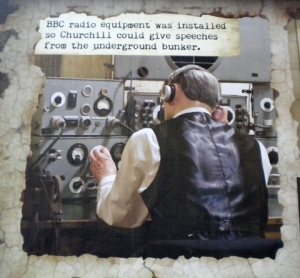
OBA8 in the Churchill War Rooms.
I was however in my last year at school and watched a bit on the only TV in the school available to us kids – all 14” screen B&W of course!
Winston Churchill’s funeral procession route:
(Click on the pictures below to see a larger or clearer version of the picture:
Click the “X” button (top right) to close the newly opened picture.)
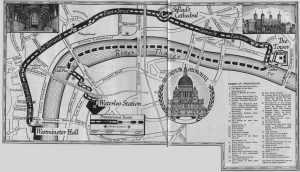
This is in this Radio Times edition (24 Jan 2015) and shows how few camera positions were used in those days.
I have a photo from Alan Woolford (latterly KA EM) of the procession from the TV position at The Tower:
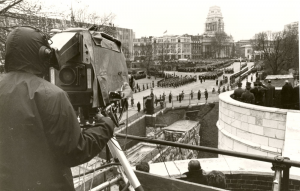
and one of Richard Dimbleby in the Comm Box.The Comm box one has someone else in it (who?).
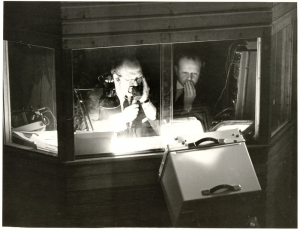
Peter Coombes
The picture below shows Dimbleby in the Triforium during Churchill’s funeral. He has one hand to his ear. Is this the moment that the talkback failed? And is that Jeff behind his left shoulder?
Incidentally, where was the photographer? Hanging from the dome?
(Click on the pictures below to see a larger or clearer version of the picture:
Click the “X” button (top right) to close the newly opened picture.)
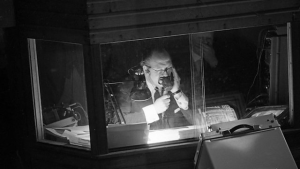
(the version below of the photo has the gamma tweaked a bit…)
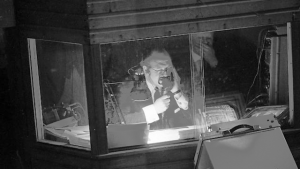
—
(ed: the photos of RD from Mike and Peter are different but must have been taken about the same time)
—
Jeff Baker
The commentary box, necessary so that the commentary was not heard throughout the cathedral, was quite small, and was positioned a little way back from the edge of the Triforium. Hence there was room for monitors in front of the box and also room for a photographer to be there.
As I recall, 3 or 4 people was about the limit in the box, and Richard was no midget, so if someone needed to get in, perhaps to advise him of something to be included in the commentary, then someone else had to get out! The traffic was fairly continuous but it didn’t seem to disturb his concentration, which was very impressive to a young lad like me.
Incidentally, that face to Richard’s right in the picture isn’t me, and I cannot identify the person now. I had to wear glasses from about the age of 6, so could never aspire to the camera elite. I would probably not have been any good at it anyway.
Dave Thompson
Some years ago I visited the Churchill War rooms. Something was being played via the OBA8 gear, probably a Churchill speech, and the PPM was working – in the wrong direction.
Those of a certain age will remember that the valve driven PPM had a right hand mechanical zero, thus allowing the mechanics of the spring return to assist the speed of the rise time of the meter.
Some forty years ago I was using a number of these Ernest Turner PPMs driven by discrete transistor ccts on a small pcb which drove the meters in the correct direction.
I sent an email to the IWM about this error and even offered to give them an eddy box containing the transistor device to correct this error. Needless to say, I had no reply, so the inaccuracy in the display is probably still there.
Alasdair Lawrance
Just wallowing in nostalgia watching the restored rerun of Churchill’s funeral. I want to say “Watch and learn” to the people who brought us the Thames Pageant.
Alan Machin
I agree with the comments on the Churchill funeral TV broadcast. They had years to prepare for it no doubt, but it was superbly done and a credit to all concerned.
Like Hugh Sheppard, I saw Churchill’s funeral procession, in my case when it passed along The Strand. Fifty years ago and a similar cold clear January morning. I had returned from Wood Norton a few weeks earlier (TO 20) and must have been the most junior Sound man on Crew 6 at the time – Mike Cotton, “Z Cars” and “Marriage Lines”. I remember seeing some of the TV transmission although I have no idea where as I had no TV set in those days.
In 1972 I bought in a sale, I have no idea why, an LP of the funeral produced for charity in 1965 by EMI (ALP 2081) in association with the BBC. It contained Richard Dimbleby’s commentary and I was surprised to hear 405-line 10,125 Hz whistle. I guess Richard was commenting from ;a bank of monitors in the Triforium of St. Paul’s which were the cause of this, despite the use of, I presume, a lip mic. In 1965 our brains would have kindly filtered out the annoying 405-line whistle from our consciousness, but by 1972 and the move to 625-lines this was no longer the case. If you have been watching the BBC Parliament repeat of the funeral this morning and heard no whistle, there is no need to attribute this to the state of your hearing as the BBC Archives contains the following interesting information:
‘…The film negatives themselves were in fairly good condition, but inevitably there was some dirt and scratches. The sound was also of relatively decent quality, however due to the nature of how it was recorded there was a high pitched whistle through much of the material….’
Alan Stokes
It was just Richard Dimbleby, no “… And with me is [insert celebrity name]. What do you think of it so far?…” etc. There was no change of commentator at each lamp post and each commentator not listening to what the previous speaker had said. You knew where you were and RD with the OB team let the pictures speak for themselves.
A very sad occasion but BBC TV OBs did us proud, as usual.
A very fine effort, also, by the team who restored the telerecording. There was originally a high pitched whistle on the sound track. It sounded as thought the sound was from a mag-track so was capable of recording the line whistle at 15,625Hz if it was in the system.
Jeff Baker
On the subject of line whistle, it was always present from the small Cathode Ray Tubed commentator’s monitors and when the commentator leaned close to the monitor with his lip mic, the microphone’s most sensitive side was closest to the monitor. You will remember that the horseshoe magnet was part of the blast shield for the ribbon and left it exposed to any sound approaching from the rear of the mic. The heavy bass filtering incorporated in the mic did nothing to reduce line whistle either!
Ian Norton
I wasn’t there, being a little younger, I was still at school in Somerset.
My headmaster instructed us to watch Churchill’s funeral on television, saying it was history in the making.
Since many on this list were there. I would like to take this opportunity of thanking all those involved for their efforts in transmitting such an historical event, to those who could not be present.
… and the Coronation of Queen Elizabeth II
Albert Barber
… memories of that other great television phenomenon – The Coronation? Ah yes…1953, “The Eagle”, Meccano and school milk. As we didn’t have a TV, we had to wait till it was shown at the local Regal. In colour too.
Mike Jordan
This is from the Coronation: the Trafalgar Square control room:
(Click on the picture below to see a larger or clearer version of this picture:
Click the “X” button (top right) to close the newly opened picture.)
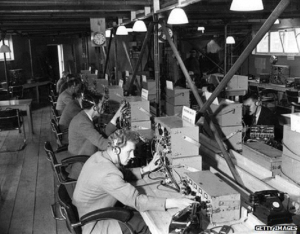
Graeme Wall
I remember we had a street party and, oddly, having green jelly for the first time! One of the neighbours had a brand new TV and it was brought to the front window of their living room so we could all have a peer at it.
Alec Bray
My maternal grandparents had a 9” TV – one of the very first in the street (Grandad was a ganger on the Great Western … ooops British Railways, but had made crystal sets and so on and was interested in TV). Neighbours from around crammed into my grandmother’s living room (not the “front room”, that was sacrosanct), and I remember the ferrrying of cups of tea from the kitchen to the assembled throng.


